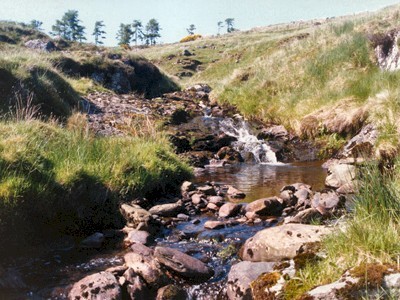Earth Science Conservation Review
| Oughtboy Burn | Tyrone |
| Site Type: | Stream section |
| Site Status: | ESCR |
| Grid Reference: | H592952 |
| Google maps: | 54.80161,-7.07944 |
| Rocks | |
|---|---|
| Rock Age: | Precambrian (Dalradian) |
| Rock Name: | Glenelly Formation, Oughtboy Burn Member, Southern Highlands Group |
| Rock Type: | Green beds |
| Interest | |
Summary of site:
The Southern Highland Group is the last of the Ancient Dalradian rocks in Northern Ireland. It is subdivided into the Dart Formation below and the Glenelly Formation above. Within the Glenelly Formation which consists largely of altered mudstones and shales (now schists) there are four marker horizons and the rocks in Oughtboy Burn expose the lowest. This horizon, named the Oughtboy Burn Member, consists of about 70 m of green schists that contrast strongly with the grey, quartz-dominated sediments above and below. The greenness is due to the mineral chlorite which, with the dark mica, biotite, forms the matrix of the rock in which are suspended well formed crystals (porphyroblasts) of chlorite and a sodium-rich plagioclase feldspar, albite. These crystals were formed during the metamorphism that altered the original rocks and the albite crystals define the original sedimentary bedding planes.
Their contacts with the general grey, quartz-rich rocks above and below suggest an unbroken period of deposition.
These rocks are around 595 million years old and were formed at a time when the area which is now Northern Ireland was part of an unstable supercontinent at the South Pole. It was rifting in response to deep-seated convection currents that were stretching the crust creating basins that filled with sediment in earlier Dalradian times but the thin crust was breached in many places resulting in extensive volcanic activity. These processes continued into Glenelly Formation times and although volcanic activity was waning, it had not ceased. The original sediments of the Oughtboy Burn Member were formed during this late burst of activity either from volcanic ash falls or eroding basaltic rocks. These sediments, in their consolidated form, existed for around 130 million years when they were involved in a collision of continental masses. This resulted in gigantic regional folding and deep burial causing the general metamorphism that we see today. All the rocks in the area of the burn are overturned in the inverted limb of this fold. The cleavage (splitting planes) of these rocks aligns with the axis of the main fold and is also a result of the episode.
The best exposure of the Oughtboy Burn Member is at this locality which gives the member its name. It is therefore the type locality (stratotype) the standard reference for all comparisons.
There are no threats to this section.
Their contacts with the general grey, quartz-rich rocks above and below suggest an unbroken period of deposition.
These rocks are around 595 million years old and were formed at a time when the area which is now Northern Ireland was part of an unstable supercontinent at the South Pole. It was rifting in response to deep-seated convection currents that were stretching the crust creating basins that filled with sediment in earlier Dalradian times but the thin crust was breached in many places resulting in extensive volcanic activity. These processes continued into Glenelly Formation times and although volcanic activity was waning, it had not ceased. The original sediments of the Oughtboy Burn Member were formed during this late burst of activity either from volcanic ash falls or eroding basaltic rocks. These sediments, in their consolidated form, existed for around 130 million years when they were involved in a collision of continental masses. This resulted in gigantic regional folding and deep burial causing the general metamorphism that we see today. All the rocks in the area of the burn are overturned in the inverted limb of this fold. The cleavage (splitting planes) of these rocks aligns with the axis of the main fold and is also a result of the episode.
The best exposure of the Oughtboy Burn Member is at this locality which gives the member its name. It is therefore the type locality (stratotype) the standard reference for all comparisons.
There are no threats to this section.
| Enlander, I., Dempster, M. & Doughty, P., 2025. Oughtboy Burn, County Tyrone, site summary. [In] Earth Science Conservation Review. https://www.habitas.org.uk/escr/summary.php?item=134. Accessed on 2025-04-03 |
| Previous Site | Next Site |

